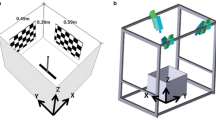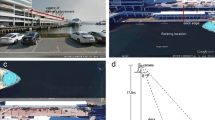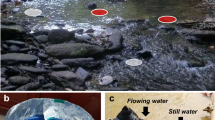Summary
Watestriders (Gerris paludum F.), displaced by flowing water or wind, compensate for this by periodic jumps against the direction of drift so that they keep their average position — relative to the river bank, for instance — constant over long periods of time. To identify the cues used by the animals to compensate for drift, they were kept on an artificial stream with visual patterns along one or both sides. The velocity of the water flow and the pattern motion were varied. It is not possible to induce compensatory jumps in darkness by water or air current alone. Visual cues are indispensable for the reaction. The product of jump amplitude and jump frequency equals the drift velocity on average. The jump amplitudes are more or less independent of the flow velocity while the jump frequency is adjusted to it.
Similar content being viewed by others
References
Bedau K (1911) Das Facettenauge der Wasserwanzen. Z Wiss Zool 97:417–456
Borst A, Bahde S (1986) What kind of movement detector is triggering the landing response of the housefly? Biol Cybern 55:58–69
Buchner E (1976) Elementary movement detectors in an insect visual system. Biol Cybern 24:85–101
Cartwright BA, Collett TS (1982) How honey bees use landmark to guide their return to a food source. Nature 295:560–564
Cartwright BA, Collett TS (1983) Landmark learning in bees. J Comp Physiol 151:521–543
Collett TS (1980) Some operating rules for the optomotor system of a hoverfly during voluntary flight. J Comp Physiol 138:271–282
Collett TS, Land MF (1975) Visual control of flight behaviour in the hoverfly, Syritta pipiens. J Comp Physiol 99:1–66
Dahmen HJ, Junger W (1988) Adaptation to the watersurface: Structural and functional specialization of the gerrid eye. In: Elsner N, Barth FG (eds) Sense organs. Interfaces between environment and behaviour. Thieme, Stuttgart New York, p 233
Görner P (1973) Beispiele einer Orientierung ohne richtende Außenreize. Fortschr Zool 21:20–45
Hamann B, Langer H (1980) Sehfarbstoffe im Auge des Wasserläufers Gerris lacustris. Verh Dtsch Zool Ges 73:337
Hart DD (1987) Feeding territoriality in aquatic insects: cost-benefit models and experimental tests. Am Zool 27:371–386
Hausen K (1982) Motion sensitive interneurons in the optomotor system of the fly. 2. The horizontal cells: receptive field organization and response characteristics. Biol Cybern 46:67–79
Hausen K, Egelhaaf M (1989) Neural mechanism of visual course control in insects. In: Stavenga DG, Hardie RC (eds) Facets of vision. Springer, Berlin Heidelberg New York, pp 391–424
Heran H, Lindauer M (1963) Windkompensation und Seitenwindkorrektur der Bienen bei Flug über Wasser. Z Vergl Physiol 47:39–55
Jamieson GS, Scudder GGE (1979) Predation in Gerris (Hemiptera): Reactive distances and locomotion rates. Oecologia (Berlin) 44:13–20
Jander R, Horn E, Hoffmann M (1970) Die Bedeutung der Gelenkrezeptoren in den Beinen für die Geotaxis der höheren Insekten (Pterygota). Z Vergl Physiol 66:326–342
Junger W, Dahmen HJ (1986) Visually induced drift compensation in waterstriders. Verh Dtsch Zool Ges 79:217
Kirchner WH, Srinivasan MV (1988) Estimation of distance using motion parallax in free-flying honeybees. In: Elsner N, Barth FG (eds) Sense organs: Interfaces between environment and behaviour. Thieme, Stuttgart New York, p 231
Koenderink JJ (1986) Optic flow. Vision Res 26:161–180
Koenderink JJ, Doorn AV van (1987) Facts on optic flow. Biol Cybern 56:247–254
Longuet-Higgins HC, Prazdny K (1980) The interpretation of moving retinal images. Proc R Soc Lond (B) 208:385–387
Mittelstaedt H, Mittelstaedt-Burger ML (1973) Mechanismen der Orientierung ohne richtende Außenreize. Fortschr Zool 21:46–58
Murphey RK (1971) Sensory aspects of the control of orientation to prey by the waterstrider, Gerris remigis. Z Vergl Physiol 72:168–185
Precht W (1978) Neuronal operations in the vestibular system. In: Braitenberg V (ed) Studies on brain function, vol. 2. Springer, Berlin Heidelberg New York, pp 203–210
Preiss R, Kramer E (1983) Stabilization of altitude and speed in tethered flying gipsy moth males: Influence of (+) and (-) disparlure. Physiol Entomol 8:55–68
Rensing L (1962) Beiträge zur vergleichenden Morphologie, Physiologie und Ethologie der Wasserläufer (Gerriden). Zool Beiträge 7:447–485
Rubenstein DI (1984) Resource acquisition and alternative mating strategies in water striders. Am Zool 24:345–353
Schneider L, Langer H (1969) Die Struktur des Rhabdoms im Doppelauge des Wasserläufers Gerris lacustris. Z Zellforsch 99:538–559
Shen L (1989) Neural integration by short term potentiation. Biol Cybern 62:319–325
Wehner R (1981) Spatial vision in arthropods. In: Autrum H (ed) Vision in invertebrates (Handbook of sensory physiology), Vol. VII/6C. Springer, Berlin Heidelberg New York, pp 287–616
Wilson DS, Leighton D, Leighton M (1978) Interference competition in a tropical ripple bug (Hemiptera: Veliidae). Biotropica 10:302–306
Wiese K (1974) The mechanoreceptive system of prey localization in Notonecta. J Comp Physiol 92:317–325
Zanker JM, Collett TS (1985) The optomotor system on the ground: on the absence of visual control of speed in walking ladybirds. J Comp Physiol A 156:395–402
Zeil J, Wittmann D (1989) Visually controlled station-keeping by hovering guard bees of Trigona (Tetragonisca) angustula (Apidae, Meliponinae). J Comp Physiol A 165:711–718
Author information
Authors and Affiliations
Rights and permissions
About this article
Cite this article
Junger, W., Varjú, D. Drift compensation and its sensory basis in waterstriders (Gerris paludum F.). J Comp Physiol A 167, 441–446 (1990). https://doi.org/10.1007/BF00192580
Accepted:
Issue Date:
DOI: https://doi.org/10.1007/BF00192580




